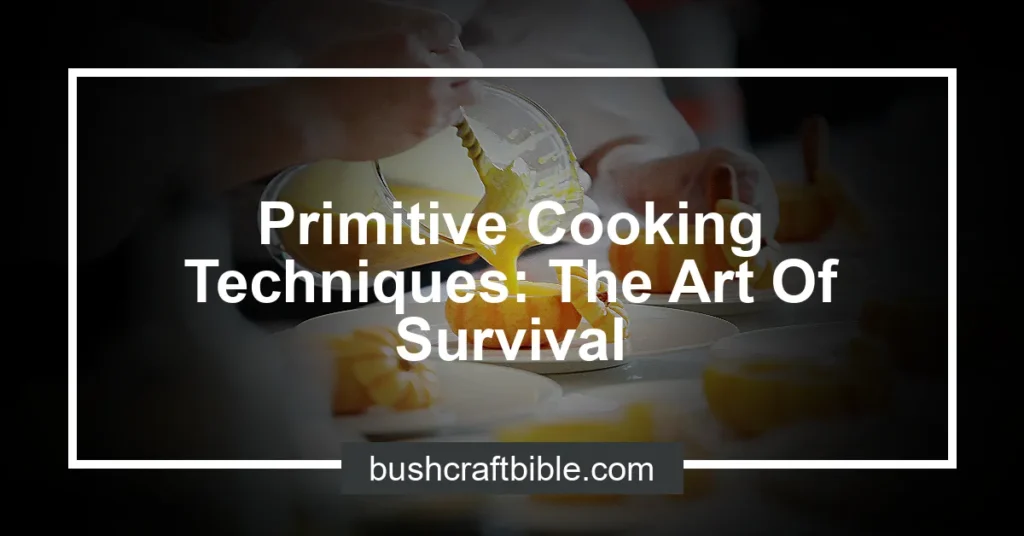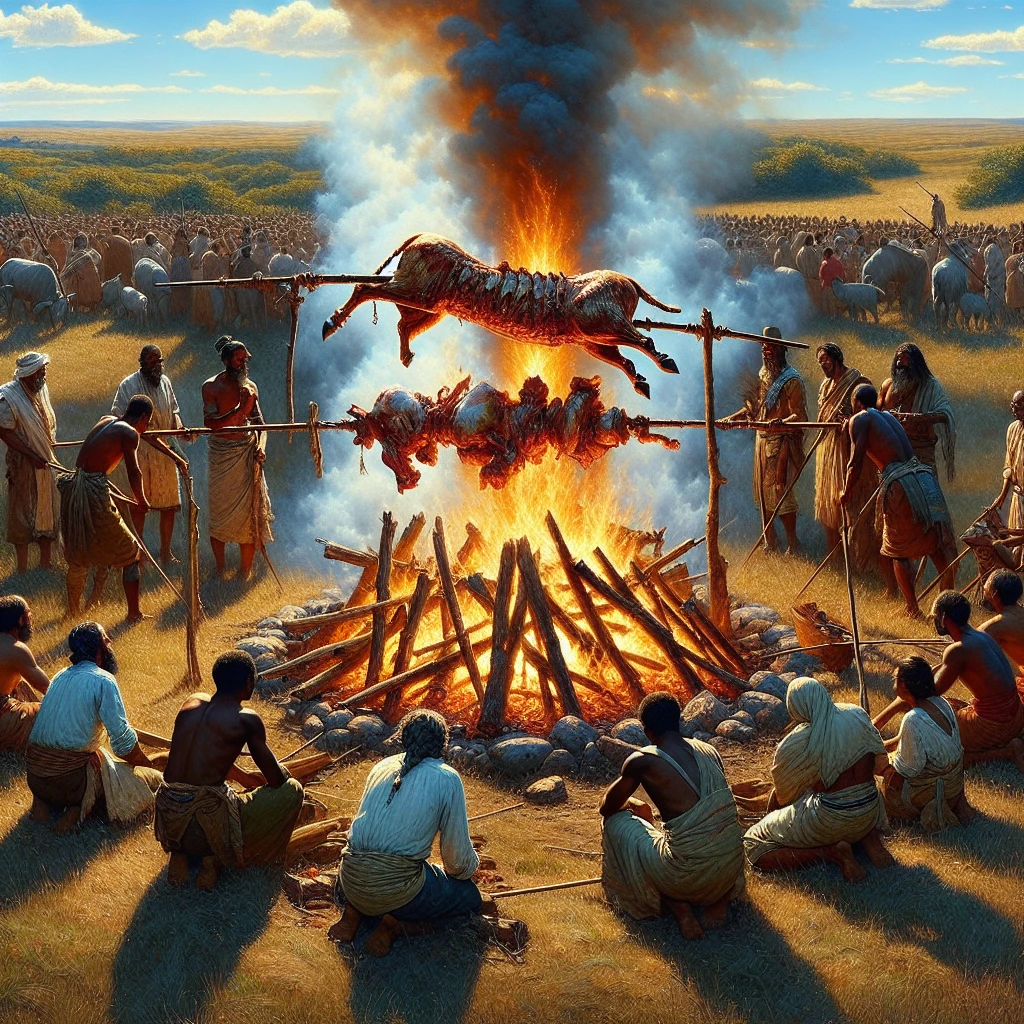

Primitive cooking techniques refer to the traditional methods of cooking using natural materials and resources, such as fire, stones, and leaves. These techniques are often used in survival situations where modern cooking equipment is not available.
Primitive cooking techniques are important in survival situations as they allow individuals to prepare food for nourishment and sustenance without the need for modern tools and appliances. Mastering these techniques can be crucial for survival in outdoor or emergency situations where access to electricity or gas is limited.
Learning primitive cooking techniques is essential for anyone interested in outdoor activities, camping, or survival skills. By understanding and practicing these methods, individuals can become more self-sufficient and better prepared for unexpected situations where conventional cooking methods may not be viable.
Check out this Youtube video: Learn a unique and primal way of cooking a steak using only a rock and fire, perfect for anyone interested in primitive cooking techniques or survival skills!
Historical Background
Evidence of primitive cooking techniques in ancient civilizations
The evidence of primitive cooking techniques in ancient civilizations can be traced back to approximately 1.9 million years ago. These early humans utilized basic tools such as sharpened rocks and flint to process and cook food.
The control of fire played a pivotal role in the evolution of cooking, allowing for the transformation of raw meat and vegetables into more digestible and flavorful sustenance.
Evolution of cooking methods from primitive to modern
The evolution of cooking methods from primitive to modern has been a remarkable journey. Initially, humans used direct exposure to flame and hot stones for cooking.
Over time, advancements in culinary techniques led to the development of pottery, allowing for versatile cooking vessels. The innovation of techniques such as boiling and steaming further enhanced the diversity of cooked foods.
With the industrial revolution, the integration of gas and electric stoves revolutionized cooking, paving the way for the modern culinary landscape.
| Primitive Cooking Techniques | Evolution to Modern Methods |
|---|---|
| Basic tools and fire control | Introduction of pottery and versatile cooking vessels |
| Direct exposure to flame and hot stones | Innovation of boiling and steaming techniques |
| Limited access to cooking resources | Integration of gas and electric stoves |
Let’s take a moment to appreciate the fascinating progression of cooking from its humble primitive origins to the sophisticated culinary practices of today.
The evidence indicates that early humans were innovative and resourceful in developing techniques that would form the foundation for modern cooking methods. This historical insight provides a deeper understanding of the integral role cooking has played in human civilization.
The Art of Fire-Making
Importance of fire in primitive cooking
Fire is crucial in primitive cooking as it enabled early humans to cook food, making it safer to consume and easier to digest. Additionally, fire provided warmth and protection from predators, allowing our ancestors to gather around and share meals, fostering social bonds that contributed to the evolution of human society.
Different methods of fire-making for cooking
Early humans used various methods to make fire for cooking, such as friction-based methods like the fire plow and bow drill, as well as flint and steel for sparking tinder. These techniques allowed them to ignite fires and cook meals, marking a significant advancement in their culinary abilities and ensuring their survival in the wild.
| Method | Description |
|---|---|
| Friction-based | Utilized rubbing or drilling actions to generate heat and spark, igniting the cooking fire. |
| Flint and Steel | Involving striking steel against flint to create sparks, which were then used to light tinder. |
Let’s make primitive cooking great again by remembering the importance of fire and the diverse methods our ancestors used for cooking.
Earth Ovens
To build an earth oven, start by creating a base using a mix of sand and clay, shaping it into a hemisphere. Cover this with layers of mud, and once dry, remove the sand to leave a hollow.
To use the oven, start a fire inside and allow it to burn down, creating a smolder. Then, place the food inside the oven and cover it for baking or steaming.
For baking, lay flat stones inside and fire the oven for the best wood-fired pizza right in your backyard.
When it comes to the advantages of earth ovens, they offer the ability to cook using a local, renewable resource like wood, which enhances the flavor of the food. Additionally, they can cook large quantities of food without the need for modern equipment, making them ideal for communal cooking.
Ash Cooking
Process of ash cooking
Ah, ash cooking, a technique as old as time itself! The process involves using alkaline solutions derived from wood ash to cook food, particularly corn in a method known as nixtamalization.
This method has been practiced for centuries, originating from Mesoamerica and bringing out the true essence of corn by breaking down its outer shell and endosperm. The traditional way of nixtamalizing involves soaking and cooking the corn in an alkali solution, transforming it from something resembling “toxic cardboard” to a nutritious staple of the Mesoamerican diet.
Let’s dive into the specifics of the process, shall we? The corn is typically cooked in an alkaline solution, often made from hardwood ash, to enhance its nutritional content and decrease cooking time.
This not only improves the taste and smell of the food but also adds to its nutritional value. The ash filtrate aids in making hard-to-cook foods more palatable and readily consumable, all thanks to the power of ash cooking!
Advantages and disadvantages of ash cooking
Now, let’s weigh the merits and demerits of ash cooking. The use of wood ash in cooking fortifies the nutritional value of the food and decreases the cooking time – a significant advantage.
However, some may argue that the alkaline solution alters the flavor profile of the food, leading to a potential downside for those with sensitive taste buds. Despite this, the historical and nutritional benefits of ash cooking cannot be disregarded.
It’s a true testament to the resourcefulness of our ancestors and a fascinating culinary technique that continues to have relevance in today’s gastronomic world.
Here’s a summary in table form:
| Advantages | Disadvantages |
|---|---|
| Fortifies nutritional value | Alters flavor profile |
| Decreases cooking time | Sensitivity to taste |
The process of ash cooking, particularly in nixtamalization, brings significant advantages to the table, offering a unique blend of historical significance and tangible benefits for modern-day culinary enthusiasts.
Remember, folks, ash cooking isn’t just about the process – it’s about embracing the rich cultural heritage and nourishing our bodies in a way that has stood the test of time!
Hot Stone Cooking
Using hot stones for cooking involves heating stones in a fire and then utilizing them to cook food. The stones retain heat for a long time, allowing for consistent cooking temperatures.
This method is particularly useful in primitive settings where modern cooking equipment is not available.
Benefits of hot stone cooking in primitive settings include the ability to cook food without direct exposure to flames, reducing the likelihood of burning. Additionally, it ensures even cooking throughout, minimizing the risk of food poisoning.
The method also proves to be effective in cooking a variety of foods, making it a versatile and reliable option for primitive cooking.
| Benefits of Hot Stone Cooking in Primitive Settings |
|---|
| Enhanced Safety from Direct Flames |
| Even Cooking to Prevent Food Poisoning |
| Versatility in Cooking Different Foods |
Spit Cooking
The process of spit cooking over an open flame
Spit cooking involves skewering food on a long rod and rotating it over an open flame. The food slowly cooks as it spins, allowing for even heat distribution and a delicious, smoky flavor.
This ancient method of cooking has been used for centuries and is a classic way to prepare large cuts of meat or whole animals.
Examples of foods that are best cooked using this method
Foods that are best cooked using spit cooking include whole chickens, large roasts of beef or lamb, and even whole fish. The slow rotation over the open flame ensures that the meat cooks evenly and retains its natural juices, resulting in tender and flavorful dishes.
Additionally, vegetables such as bell peppers, onions, and even pineapples can be skewered and roasted using this method, adding a delightful smoky char to their natural sweetness.
Steam Pit Cooking
Steps in steam pit cooking
To start steam pit cooking, first, create a pit and heat rocks inside a fire. Once the rocks are hot, place them in the pit, and cover with 4 inches of damp soil or sand for insulation.
Add a layer of 8-12 inches of green vegetation, then place your food in a single layer on top of the vegetation. Finally, cover the food with more greenery and a tarp, then let it cook for several hours to infuse the food with a smoky, earthy flavor.
Foods that are suitable for steam pit cooking
Steam pit cooking is ideal for cooking root vegetables like potatoes, carrots, and beets. Additionally, seafood such as fish, crab, and shellfish can be perfectly cooked using this method.
The steam and heat from the pit infuse these foods with a unique flavor, making them tender and delicious.
| Food Type | Suitability for Steam Pit Cooking |
|---|---|
| Root Vegetables | Ideal |
| Seafood | Perfect |
Clay Cooking
Clay cooking, also known as clay pot cooking, is a technique of preparing food using clay pots or vessels. These pots are made from natural clay and are known for their ability to retain and conduct heat, making them ideal for slow, even cooking.
The porous nature of clay also allows for the natural circulation of steam and flavors, resulting in delicious and tender dishes.
Cooking in clay pots or vessels involves using them directly on open flames or in ovens. The pots are soaked in water prior to cooking to create a steamy environment, which helps in maintaining moisture and tenderness in the food.
This traditional cooking method imparts a unique earthy flavor to the dishes and is revered for its ability to enhance the overall dining experience.
The benefits of clay cooking in primitive environments are numerous. Clay pots are versatile and can be used for a wide range of cooking methods, including boiling, stewing, steaming, and baking.
In primitive settings, where resources may be limited, clay pots provide a reliable and durable cooking vessel. Additionally, the even heat distribution in clay pots ensures that food is thoroughly and evenly cooked, making them essential for survival in the wild.
Furthermore, cooking in clay pots has environmental benefits. Clay is a natural and sustainable material, making it an eco-friendly choice for cooking vessels.
As a result, clay cooking aligns with the principles of sustainable living and offers a practical solution for preparing meals in primitive environments. The technique of cooking with clay pots continues to be valued for its ability to deliver hearty and flavorful meals while embracing sustainability and tradition.
Survival Cooking Tips
Tips for successful primitive cooking
When it comes to successful primitive cooking, mastering the art of fire-making is essential. Utilize fire, sticks, stones, and bones to create a sustainable cooking fire.
Additionally, familiarize yourself with makeshift cooking methods such as earth ovens, primitive stone ovens, and dehydrating food. These techniques are vital for ensuring successful primitive cooking in the wilderness.
Common mistakes to avoid in primitive cooking techniques
One common mistake to avoid in primitive cooking is uneven cooking due to inadequate fire management. Novice outdoor food preparers often make the mistake of leaving the inside unpleasantly uncooked by relying solely on flames.
Instead, maintain a balanced fire to ensure even and thorough cooking. Moreover, it’s crucial to avoid haphazardly placing food directly in the fire, which can lead to burnt exteriors and raw interiors.
Mastering these fundamental techniques is key to successful and satisfying primitive cooking experiences.
Examples of Primitive Cooking Techniques in Different Cultures
Cultural significance of traditional cooking techniques
| Cooking Method | Cultural Significance |
|---|---|
| Roasting on Hot Coals | Represents a method of cooking meats, fish, and other foods, symbolizing the communal aspect of food preparation |
| Smokehouses | Preserves and enhances the flavor of meats, acting as a cultural tradition depicting the importance of food |
| Pit Cooking | Reflects the resourcefulness and adaptability of indigenous cultures, showcasing their close connection to nature |
The Future of Primitive Cooking Techniques
Modern adaptations of primitive cooking methods
The future of primitive cooking techniques lies in the innovative adaptation of traditional methods to suit modern needs. With advancements in technology, preppers and survival enthusiasts are exploring new ways to implement age-old techniques by integrating modern tools and equipment for efficient and practical cooking solutions.
For instance, utilizing solar ovens and eco-friendly fuel sources to replicate the effects of traditional open-fire cooking while minimizing environmental impact showcases the evolution of primitive methods in contemporary settings.
Incorporating primitive cooking techniques into modern lifestyles
Incorporating primitive cooking techniques into modern lifestyles involves striking a balance between historical practices and current convenience. As individuals seek to reconnect with nature and ancestral skills, there’s a growing trend of integrating primitive cooking methods into recreational activities, such as camping and outdoor gatherings.
Additionally, the rise of artisanal culinary experiences and farm-to-table movements has sparked a renewed interest in traditional cooking approaches, fostering a deeper appreciation for the simplicity and ingenuity of primitive culinary practices.
| Primitive Method | Modern Adaptation |
|---|---|
| Grilling/Broiling | Solar-powered grills and eco-friendly fuels |
| Leaf Oven | Portable clay ovens and eco-conscious materials |
| Bamboo Tube Cooking | Stainless steel steamers and sustainable bamboo alternatives |
| Hot Rock Boiling | Induction cooktops replicating hot stone cooking |
| Primitive Oven | Clay or ceramic outdoor pizza ovens |
It’s fascinating to witness the fusion of ancient wisdom with contemporary needs, shaping the future of primitive cooking techniques into a harmonious blend of tradition and innovation. As we embrace these adaptations, we honor the resilience and resourcefulness of our ancestors while embracing the practicalities of modern living.
Recommended Amazon Products for Primitive Cooking Techniques
Here’s a curated list of products that can help you master primitive cooking with ease. These recommendations are based on quality, functionality, and positive customer reviews.

 Cast Iron Dutch Oven
Cast Iron Dutch Oven


The cast iron dutch oven is a versatile cookware that can be used directly over an open flame, making it perfect for earth oven cooking and ash cooking. This durable and efficient cooking tool has received excellent feedback from outdoor cooking enthusiasts.

 Fire Starter Kit
Fire Starter Kit


A reliable fire starter kit is essential for practicing various primitive cooking techniques. It provides the means to efficiently create fire, a crucial element in hot stone cooking, spit cooking, and other methods.
This kit is highly recommended for its functionality and ease of use.

 Portable Campfire Grill
Portable Campfire Grill


A portable campfire grill allows for easy and efficient spit cooking over an open flame. It is also suitable for using with hot stone cooking techniques.
This product is lauded for its portability and sturdy construction.

 Clay Cooking Pot
Clay Cooking Pot


The clay cooking pot is an authentic choice for those interested in experimenting with clay cooking. It’s well-suited for steam pit cooking and offers the benefits of retaining heat for prolonged cooking times.
This traditional cookware has garnered positive reviews for its authenticity and cooking performance.

 Outdoor Cooking Tripod
Outdoor Cooking Tripod


An outdoor cooking tripod is designed for use with hanging cooking vessels, making it ideal for steam pit cooking and spit cooking applications. This sturdy and adjustable tool is highly regarded for its stability and versatility.
Top Recommended Product for Primitive Cooking Techniques
If you’re looking for the best solution for mastering primitive cooking techniques, we highly recommend the Cast Iron Dutch Oven (https://www.amazon.com/s?k=cast+iron+dutch+oven). This versatile and durable cookware is an essential tool for various primitive cooking methods. It has earned widespread acclaim for its quality and performance, making it the top choice for enthusiasts of outdoor and primitive cooking. Ready to elevate your primitive cooking skills? Check out the Cast Iron Dutch Oven (https://www.amazon.com/s?k=cast+iron+dutch+oven) today for an authentic and rewarding culinary experience!




Conclusion
Primitive cooking techniques have played a crucial role in the development of human civilization. These techniques have been essential for early human survival and have paved the way for the culinary practices we have today.
The use of open flame, hot coals, and basic tools has allowed our ancestors to cook food, making it safer to consume and providing the necessary sustenance for survival.
Moreover, the application of primitive cooking techniques has not only provided nourishment, but it has also brought people together. Cooking over open fires and sharing meals has been a fundamental part of building communities and fostering social connections.
These techniques have created a sense of unity and cooperation among early humans, laying the foundation for the social aspects of cooking and eating that we still experience today.
Primitive cooking techniques have had a lasting impact on humanity, shaping the way we cook, eat, and interact with one another. The simplicity and effectiveness of these techniques have withstood the test of time, and their influence can still be seen in modern cooking practices.
As we continue to advance in culinary technology, it is important to recognize and appreciate the significance of primitive cooking techniques in our history and cultural development.
Frequently Asked Questions
What are the 3 methods of primitive cooking?
What is the oldest cooking technique?
What were the old ways of cooking?
What were the methods of cooking in the Paleolithic Age?
What is the meaning of primitive cooking?
Reference Links
- https://en.wikipedia.org/wiki/Clay_pot_cooking
- https://www.ncbi.nlm.nih.gov/pmc/articles/PMC4063875/
- https://www.quora.com/When-did-humans-start-keeping-track-of-their-method-of-cooking-or-maintaining-a-recipe










